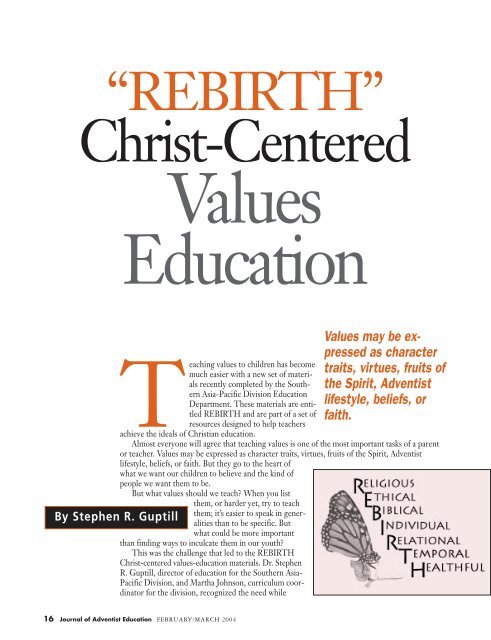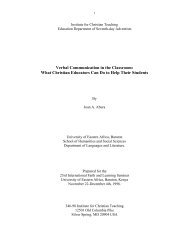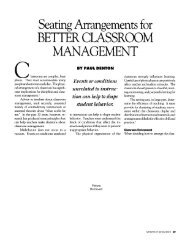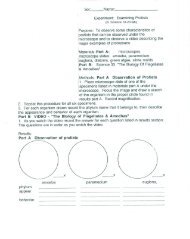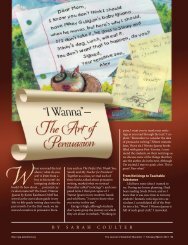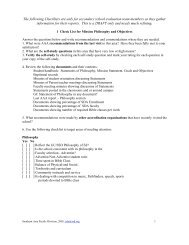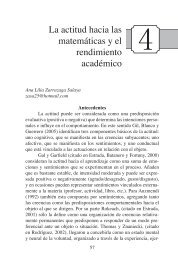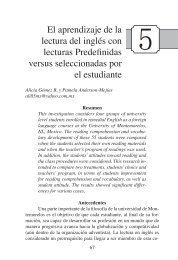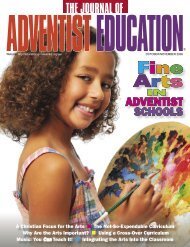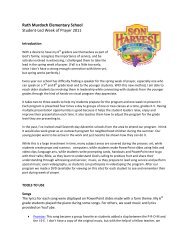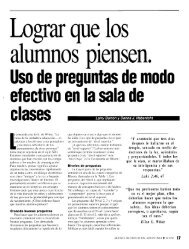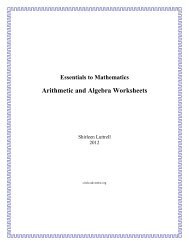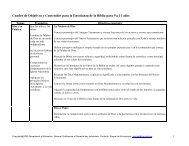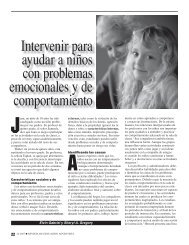REBIRTH: Christ-Centered Values Education - Circle
REBIRTH: Christ-Centered Values Education - Circle
REBIRTH: Christ-Centered Values Education - Circle
Create successful ePaper yourself
Turn your PDF publications into a flip-book with our unique Google optimized e-Paper software.
“<strong>REBIRTH</strong>”<br />
<strong>Christ</strong>-<strong>Centered</strong><br />
<strong>Values</strong><br />
<strong>Education</strong><br />
By Stephen R. Guptill<br />
Teaching values to children has become<br />
much easier with a new set of materials<br />
recently completed by the Southern<br />
Asia-Pacific Division <strong>Education</strong><br />
Department. These materials are entitled<br />
<strong>REBIRTH</strong> and are part of a set of<br />
resources designed to help teachers<br />
achieve the ideals of <strong>Christ</strong>ian education.<br />
Almost everyone will agree that teaching values is one of the most important tasks of a parent<br />
or teacher. <strong>Values</strong> may be expressed as character traits, virtues, fruits of the Spirit, Adventist<br />
lifestyle, beliefs, or faith. But they go to the heart of<br />
what we want our children to believe and the kind of<br />
people we want them to be.<br />
But what values should we teach? When you list<br />
them, or harder yet, try to teach<br />
them; it’s easier to speak in generalities<br />
than to be specific. But<br />
what could be more important<br />
than finding ways to inculcate them in our youth?<br />
This was the challenge that led to the <strong>REBIRTH</strong><br />
<strong>Christ</strong>-centered values-education materials. Dr. Stephen<br />
R. Guptill, director of education for the Southern Asia-<br />
Pacific Division, and Martha Johnson, curriculum coordinator<br />
for the division, recognized the need while<br />
16 Journal of Adventist <strong>Education</strong> FEBRUARY/MARCH 2004<br />
<strong>Values</strong> may be expressed<br />
as character<br />
traits, virtues, fruits of<br />
the Spirit, Adventist<br />
lifestyle, beliefs, or<br />
faith.
What values should we<br />
teach?<br />
preparing textbook supplements for<br />
Adventist primary and secondary<br />
school teachers. They identified one<br />
of the approaches teachers can use in<br />
making their classes <strong>Christ</strong>-centered<br />
as “teaching specific values or beliefs<br />
of faith.” But what were these values?<br />
They were not as clearly defined as<br />
the subject content. A search for the<br />
values to teach produced a number of<br />
partial lists, with certain favorite values<br />
amplified but no systematic approach<br />
for teachers.<br />
Guptill and Johnson began to<br />
compile a list of virtues and beliefs<br />
considered essential to <strong>Christ</strong>ian education.<br />
The list grew very large and<br />
included many synonyms and overlapping<br />
virtues. It was clear that some<br />
organization and grouping was necessary.<br />
In the end, 89 of the most central<br />
Adventist values and <strong>Christ</strong>ian<br />
character traits were selected and<br />
Journal of Adventist <strong>Education</strong> FEBRUARY/MARCH 2004 17
grouped into seven categories. Each<br />
of these categories or groups addresses<br />
the great issues of life and<br />
helps set children on the right path of<br />
salvation and successful living. Each<br />
letter of the <strong>REBIRTH</strong> name represents<br />
one of these virtue groups.<br />
The Religious virtues help us be<br />
like Jesus and respond to His perfect<br />
character. The Ethical virtues help us<br />
make wise decisions in life. The Biblical<br />
group includes core scriptural beliefs<br />
that form the basis for our faith<br />
and experience with God. The Individual<br />
virtues help make us become<br />
people with noble, God-like characters.<br />
The Relational virtues help us<br />
build wholesome relationships with<br />
others. The Temporal values relate to<br />
time and Adventist lifestyle. And finally,<br />
the Healthful values help us take<br />
good care of our bodies.<br />
Each virtue is expressed in terms<br />
of its relationship with God. This is<br />
how <strong>Christ</strong>ian values are different<br />
from secular ones. Despite having a<br />
similar name, a <strong>Christ</strong>ian value may<br />
be completely different from a value<br />
taught from a humanist or secular<br />
18 Journal of Adventist <strong>Education</strong> FEBRUARY/MARCH 2004<br />
A search for the values<br />
to teach produced a<br />
number of partial lists,<br />
with certain favorite<br />
values amplified but no<br />
systematic approach<br />
for teachers.<br />
perspective. Also, it may be valued for<br />
a totally different reason.<br />
With the core virtues identified,<br />
the next challenge was how to<br />
teach them. Visual aids and resources<br />
were needed. How could<br />
teachers help students progress<br />
from knowing what is right and<br />
wrong to owning and affirming<br />
the value as part of their character?<br />
A beautifully illustrated flip<br />
chart was created. Finding artwork<br />
that illustrated all the<br />
virtues and beliefs proved to be<br />
difficult. Fortunately, Marvin<br />
Marcelino, a local pastor and<br />
artist, offered his talents. He and<br />
two other artists produced a<br />
wonderful set of illustrations for each<br />
of the core values.<br />
In developing the curriculum materials,<br />
we sought to provide a simple<br />
definition of each value that helps<br />
students understand what is right and<br />
good and how it came from God.<br />
“Choice statements” for each value<br />
help the children express their desire<br />
to embrace that value or belief as<br />
their own.<br />
Next, we collected resources and<br />
teaching ideas for each value. This
proved to be an endless task. Students<br />
and faculty from the Adventist International<br />
Institute for Advanced Studies<br />
(AIIAS), the General Conference<br />
graduate school located near the<br />
division office in the Philippines,<br />
provided a wealth of materials. A<br />
workshop for college education department<br />
faculty and secondary and<br />
primary teachers produced additional<br />
resources. The product was the RE-<br />
BIRTH Resource book, a companion<br />
to the flip chart, which included<br />
teaching aids for every virtue. It became<br />
a model for teachers to use in<br />
building their own collection of value<br />
resources. The resource book includes<br />
art, music, Bible stories, Ellen<br />
White comments, value stories from<br />
other books, links to school subjects,<br />
student activities, applications for student<br />
life, and evaluation questions. To<br />
assist teachers wanting to create their<br />
own value materials for bulletin<br />
boards, handouts, and projects, there<br />
is a clip art CD with the pictures and<br />
drawings for each value.<br />
Looking back on the project, we<br />
have several observations:<br />
1. The process of selecting values is<br />
almost as important as the final decision.<br />
When a community focuses on<br />
the specific values they want their<br />
children to learn, they are more likely<br />
Each virtue is expressed<br />
in terms of its<br />
relationship with God.<br />
<strong>Values</strong> - “Freedom”“Salvation”<br />
Value - “Learning”<br />
Louis Rath’s <strong>Values</strong> Criteria<br />
1. Choosing freely. No one can force you to embrace a value. You choose<br />
it and act upon it even when you are not being observed.<br />
2. Choosing from alternatives. You choose after thoughtful consideration<br />
of the consequences of each alternative. You choose this way to believe<br />
and act, even when you are unable to say so out loud.<br />
3. Choosing after thoughtful consideration. You are committed to your<br />
choice even after thoughtful consideration of the consequences of each<br />
alternative.<br />
4. Prizing and cherishing. You feel happy about your choice.<br />
5. Affirming. You are willing to affirm your choice to others.<br />
6. Acted upon. You act upon your choice. Although values are embraced<br />
mentally and emotionally, the actions they produce “speak louder than<br />
words.”<br />
7. Repeated. Acting repeatedly on your values creates a pattern of be-<br />
havior.—Louis E. Rath, <strong>Values</strong> and Teaching: Working With <strong>Values</strong> in the<br />
Classroom (Columbus, Ohio: Charles E. Merrill Publ. Co., 1966).<br />
to cooperate in the process of teaching<br />
the values. Discussing and deciding<br />
on which values to teach is an exercise<br />
that the board, faculty, church,<br />
and parents would do well to consider.<br />
It helps highlight what they<br />
really want to accomplish beyond<br />
conveying the subject content. For<br />
instance, what do <strong>Christ</strong>ian parents<br />
want their 4th graders to learn about<br />
a <strong>Christ</strong>ian lifestyle, personal devotional<br />
habits, health, and Bible beliefs?<br />
How can we find out? Should<br />
we schedule a brainstorming session<br />
where these character traits are identified<br />
and expressed in tangible and, if<br />
possible, measurable terms? School<br />
leaders, teachers, and parents<br />
can work together to<br />
make specific plans about<br />
how and when these<br />
virtues will be taught. This<br />
does not negate the work<br />
of professional curriculum<br />
developers, who also address<br />
these values, but it<br />
does give focus to local<br />
concerns and increases<br />
local participation and involvement.<br />
2. We also learned that<br />
there will never be a comprehensive<br />
or inclusive list<br />
of values or resources to<br />
support them. The more<br />
you work at it, the more you discover.<br />
3. Finally, values must be owned,<br />
not just memorized. <strong>Values</strong> education<br />
must go beyond the primary level<br />
where students are taught what to do.<br />
As children grow, the values must be<br />
addressed at a more mature level.<br />
Louis Rath some years ago suggested<br />
that for virtues to become values, a<br />
person must choose them freely after<br />
understanding the alternatives and<br />
consequences of the different choice<br />
(see sidebar).<br />
If students really value something,<br />
they will embrace it and be willing to<br />
publicly affirm and act on it. The<br />
challenge is to help older students<br />
work through this process. They<br />
must be shown the consequences of<br />
other choices and given opportunities<br />
Journal of Adventist <strong>Education</strong> FEBRUARY/MARCH 2004 19
to express the reasons for their values.<br />
They also need help clarifying their<br />
questions and concerns.<br />
The <strong>REBIRTH</strong> materials are<br />
being enthusiastically received by Adventist<br />
parents and teachers. Kent<br />
George, a teacher from Palawan,<br />
Philippines, says: “Our school selects<br />
a value from <strong>REBIRTH</strong> to feature<br />
every week. We tell stories about the<br />
selected value and bring it into our<br />
discussions during the different class<br />
subjects. The <strong>REBIRTH</strong> materials<br />
give us a visual and systematic way to<br />
talk about the core values we are trying<br />
to teach in our school.”<br />
Eleanor Roque, associate director<br />
Value - “Church Organization”<br />
Value - “Law of God”<br />
20 Journal of Adventist <strong>Education</strong> FEBRUARY/MARCH 2004<br />
In developing the curriculum<br />
materials, we<br />
sought to provide a<br />
simple definition of<br />
each value that helps<br />
students understand<br />
what is right and good<br />
and how it came from<br />
God.<br />
of education for the North Philippine<br />
Union, says: “The teaching of values<br />
is so important and central to the<br />
mission and objectives of our Adventist<br />
schools that we want every<br />
teacher involved. Every classroom has<br />
Value - “Creation”<br />
Value - “Gratitude”<br />
the <strong>REBIRTH</strong> flip chart and resource<br />
book, and it provides an organizational<br />
structure and visual aid for addressing<br />
the essential values we want<br />
our students to adopt.”<br />
The <strong>REBIRTH</strong> materials are not<br />
intended to take the place of the Bible<br />
or values classes but serve as a supplement<br />
for teachers or parents as they<br />
seek to emphasize or teach values.<br />
The materials provide a starting place<br />
and organization for the work of<br />
teaching <strong>Christ</strong>-centered character<br />
traits and beliefs.<br />
The <strong>REBIRTH</strong> materials are now<br />
all on the Web. See http://www.ssd.<br />
org/rebirth. For more information,<br />
contact the Southern Asia-Pacific Division<br />
<strong>Education</strong> Department by Email<br />
at edu@ssd.org ✐<br />
Stephen R. Guptill,<br />
Ed.D. M.P.H.,<br />
M.Div., is Director of<br />
<strong>Education</strong> for the<br />
Southern Asia-Pacific<br />
Division in Silang<br />
Cavite, Philippines.


